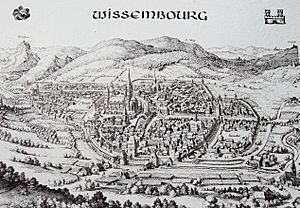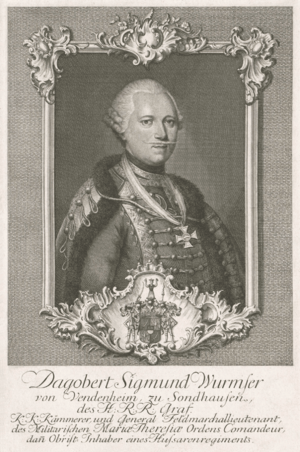First Battle of Wissembourg (1793) facts for kids
Quick facts for kids First Battle of Wissembourg |
|||||||
|---|---|---|---|---|---|---|---|
| Part of the War of the First Coalition | |||||||
 Wissembourg in the 17th century |
|||||||
|
|||||||
| Belligerents | |||||||
| Commanders and leaders | |||||||
| Strength | |||||||
| 51,590 | 42,234 | ||||||
| Casualties and losses | |||||||
| 3,000, 31 guns | 1,800 | ||||||
The First Battle of Wissembourg happened on October 13, 1793. It was a fight between the French army, led by Jean Pascal Carlenc, and an Allied army commanded by Dagobert Sigmund von Wurmser. The French army couldn't hold their ground and had to retreat. They left their strong defense line along the Lauter River and headed towards Strasbourg. This battle was part of the War of the First Coalition, a big conflict involving many European countries. It took place near the eastern border of France, about 60 kilometers (37 miles) north of Strasbourg.
Before this battle, the French Army of the Rhine had lost the city of Mainz to the Prussian army. They then moved back to the Lines of Weissenburg, a strong defensive position built way back in 1706. General Wurmser, leading an army of soldiers from Austria, German states, and French Royalists (called Émigrés), started to put pressure on these lines.
At the time, the French army was having trouble with its leaders. Two previous commanders had been arrested. So, a cavalry officer named Carlenc was chosen to lead the army. After some smaller fights, Wurmser launched a big attack that worked. Carlenc was arrested after the French retreat, and Jean-Charles Pichegru took over. Pichegru then started new attacks to try and win back the lost land. These led to more battles, including the Second Battle of Wissembourg.
Setting the Scene
During the War of the First Coalition, a large conflict in Europe, General Wurmser's Allied army was threatening to invade a part of France called Alsace. To stop them, the French Army of the Rhine took up positions in the Lines of Weissenburg. These were earthworks, like long trenches and walls, that had been there since the early 1700s. The lines started near Wissembourg and stretched about 20 kilometers (12 miles) east to the Rhine River. This area is now the border between France and Germany.
The French Army of the Rhine had a lot of changes in its leadership during this time. Commanders were often replaced. For example, General Charles de Landremont led the army for a while, but then he was arrested. After him, General Meunier was in charge for just two days before Jean Carlenc took over. Carlenc was then replaced by Charles Pichegru. Also, General Lazare Hoche was put in charge of both Pichegru's army and another French army, the Army of the Moselle.
Before the main battle, there were many smaller clashes. On August 20, Allied troops fought about 3,000 French soldiers near Jockgrim. The Allies had more success in this fight. The French lost soldiers and cannons, and their general, Louis-Théobald Ilher, was killed. After this, General Wurmser kept pushing against the French defenses with many small attacks throughout August and September.
The Battle Begins
On October 13, 1793, General Wurmser launched his main attack against the French lines. The Allied forces were strong and managed to break through the French defenses. This forced the French to retreat south towards Hagenau.
The French army suffered heavy losses. About 2,000 soldiers were killed or wounded, and 1,000 more were captured. They also lost 31 cannons and 12 flags. The Allied forces had about 1,800 casualties.
The day after the battle, an Allied force began to attack Fort-Louis, a nearby fortress on the Rhine River. The 4,500 French soldiers defending the fort surrendered it on November 14.
To help push back Wurmser, the French government quickly sent General Hoche's Army of the Moselle to the area. This led to another big fight, the Second Battle of Wissembourg, which happened in December 1793.
Armies in the Battle
Here are the main commanders and the overall strength of the armies involved:
French Army
- Overall Commander: General of Division Jean Carlenc
- Total Strength: About 45,312 infantry (foot soldiers) and 6,278 cavalry (horse soldiers).
- Key Commanders: General Jean-Baptiste Meynier led the Advance Guard. Other important commanders included Paul-Alexis Dubois, Louis Dominique Munnier, Jean Nicolas Méquillet, and Claude Ferey.
Habsburg-Allied Army
- Overall Commander: General Dagobert von Wurmser
- Total Strength: About 33,599 infantry and 9,635 cavalry.
- Key Commanders: The Allied army was divided into several columns, led by commanders like Christian, Prince of Waldeck und Pyrmont, Friedrich Freiherr von Hotze, Johann Mészáros von Szoboszló, Karl Brunner von Hirschbrunn, and Siegfried Kospoth. Prince de Condé also led a column of French Royalists.


